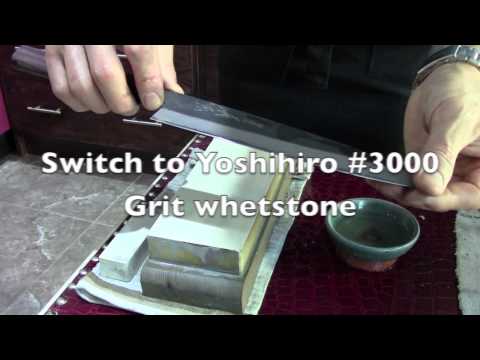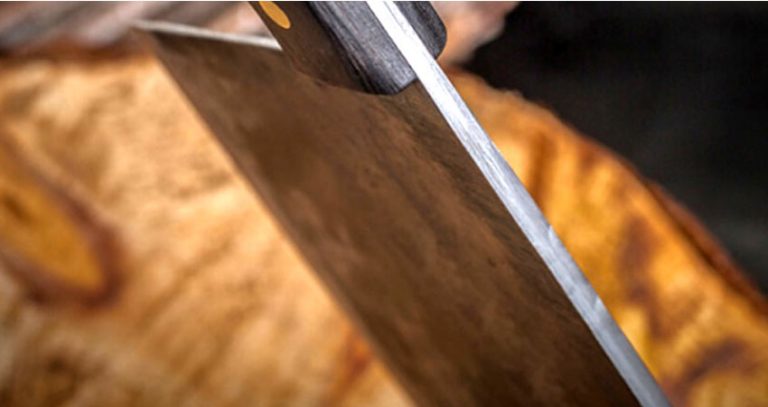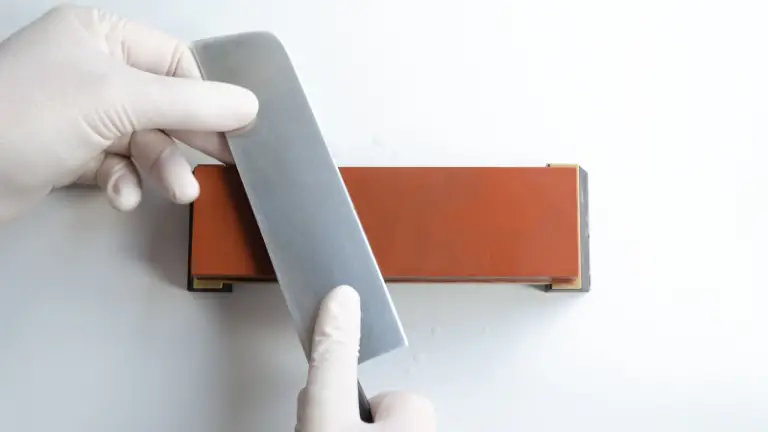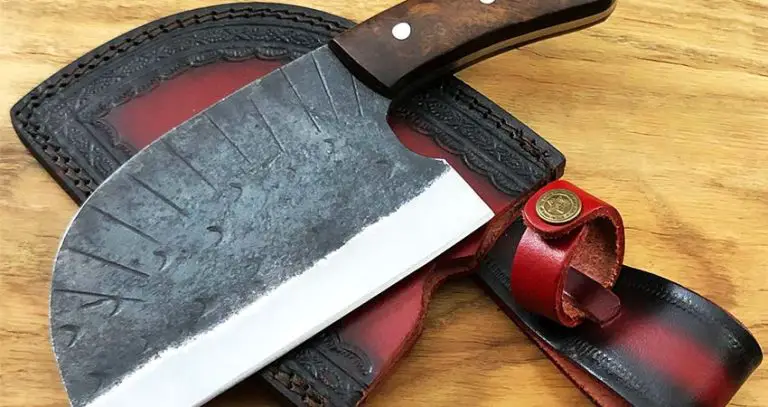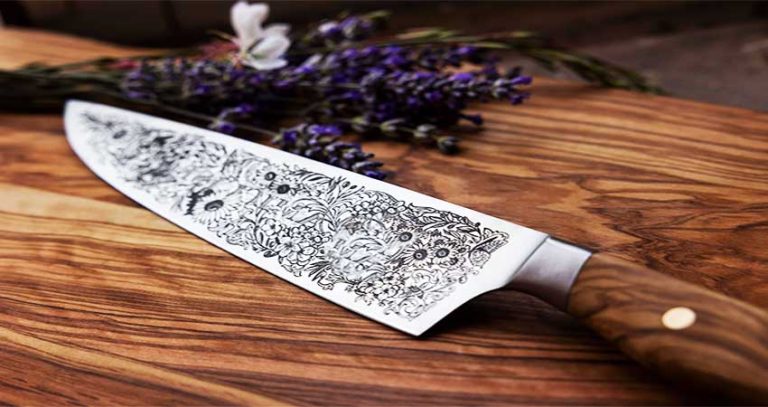How To Fix Chipped Japanese Knife?
Getting a chip in your lovely Japanese knife can be devastating or, better say, heartbreaking. But hey, it happens when you least expect it.
Maybe you used the knife to cut frozen foods, or you accidentally dropped it on your tiled floors. Whichever the case, no chip can’t be fixed somehow.
But how do you repair a chipped knife? After all, it is not safe to use a chipped knife, especially if the chip is large.
Well, there are many ways on how to fix chipped Japanese knife depending on the size and nature of the chip.
And in this guide, we’re going to discuss everything you might need to know about chipped Japanese knives and how to fix the chipping.
Why Is The Japanese Knife Chipped?

Japanese knives are crafted from high-carbon steel. That’s why you will find that they are extremely hard and tend to stay sharp for a longer time.
However, while these knives are very hard, they tend to be more brittle and prone to breakage and chips if you don’t handle them with care.
But what really causes a Japanese knife to chip? There are many causes, including:
Inappropriate Use
Basically, you are not supposed to use your Japanese knife to cut very hard ingredients such as cheese, frozen foods, hard-skinned vegetables, crusty bread, and meat/fish bones. But if you do, then the edge could chip or even crack.
Dropping The Knife On The Floor
Your Japanese knife boasts a thinner cutting edge to help you cut better. However, because of the thinness of the blade, the tip may chip if you accidentally drop the knife on the floor or on a hard surface.
Using It On A Hard Cutting Surface
While cutting boards made from marble, metal, glass, or granite may look chic in your kitchen, you should never use them with your Japanese knife.
Such boards can make your knife dull. And eventually, it may get chipped.
Twisting
Because of how thin the blade of your Japanese knife is, you should never use twisting motions when cutting your ingredients.
Doing so may cause part of the blade to dig into your cutting board and then possibly chip.
Sharpening At Too Small Of An Angle
Typically, a Japanese knife should be sharpened to 15-16 degrees on each side. But if you sharpen it at an angle less than 12 degrees, then the edge is going to be too thin to withstand the pressures once it hits the cutting board.
Consequently, it will end up chipping.
Can You Fix A Chipped Japanese Knife?
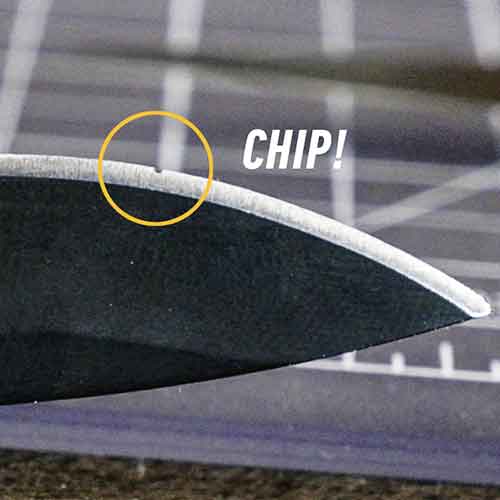
Absolutely yes. You see, even when you are careful while using your knife, it may still get a small nick in the blade. But nothing to worry about because for small knife chips, you could fix them with 1 or 2 sharpening sessions provided you have basic knowledge of knife sharpening.
Large chips on your Japanese knife, on the other hand, can also be fixed. And you don’t have to worry that the blade could get damaged. But compared to fixing a small chip, repairing large chips can be time-consuming and tedious.
However, in some cases, some chips may not be worth fixing. For example, if your knife has had the chipping in the same area a couple of times and got repaired.
In this case, you may realize that the blade is extremely thin in that specific area, and trying to repair the chipping could only damage the knife completely.
How to Fix A Chipped Japanese Knife?
So, how do you go about fixing the chipping on your knife? Well, you can easily do it in three-step parts. The first one is to grind down the knife chips, two is to thin your knife, and the third one is to sharpen the edge.
Below are easy-to-follow steps for each part.
Part One: Grind Down The Chips
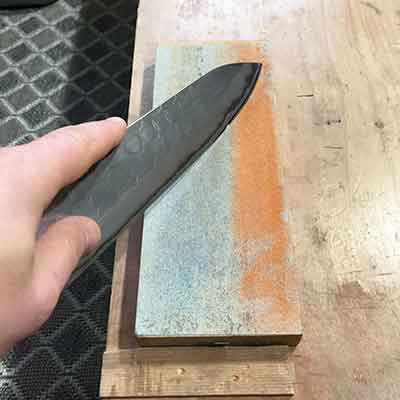
For this method, you will need a coarse sharpening stone with 220 grit or less to help you grind down the chips. Some patience will also come in handy, especially if this is your first time trying to fix a chip on a knife.
Keeping this in mind, let’s take a look at the steps to follow to ensure you grind correctly.
Step 1:
- The first step is to draw a line of your knife’s profile over the chip with a marker, so you know exactly how much steel you have to get rid of.
- The profile is simply how your knife’s blade naturally curves around the cutting area.
Step 2:
- Next, set up your knife at an angle once you already have your sharpening stone in place.
- You can place the knife at a 45 or even 70-degree angle.
- This will help grind down the chips much faster.
- And for the best results, it is advisable that you first soak the stone in water to ensure it’s wet while using it.
Step 3:
- Once your knife is set at an aggressive angle, it’s now time to start grinding down the chips.
- The right way to do it is by using the sweeping motion technique from tip to heel as you move the knife along the length of the sharpening stone.
- It is also important that you do the grinding slowly without applying so much pressure.
- More so, be sure to keep alternating the sides after every 20 passes or so to ensure you don’t end up with an off-center edge.
Part Two: Thinning Your Knife’s Bevel
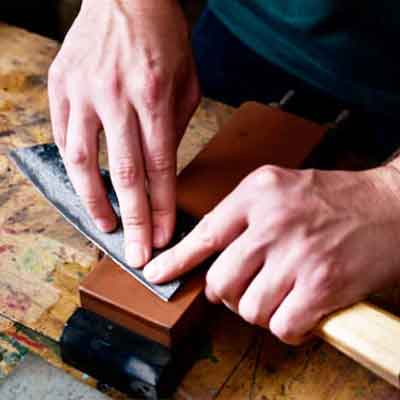
After grinding down all the knife chips, you just don’t stop there. You need to thin the bevel or simply the thick part behind your knife’s edge to ensure it glides through the food with so much ease.
And here are steps on how to properly do the thinning.
Step 1:
- First, you will need a 220-grit stone which could be the same one you used while grinding down the chips.
Step 2:
- Place the stone on a flat surface. However, you must make sure the stone is as flat as possible, and you can achieve this with the help of a strong stone.
- The reason for doing this is to ensure your bevel is evenly thinned.
Step 3:
- Next, lay your Japanese knife flat on your 220-grit stone.
- Then, using your fingers, try to apply as much force as you can on the bevel to give it a bit of an angle and start moving the knife back and forth across the stone.
- And just like when grinding, you must alternate the sides while thinning the bevel to ensure you achieve even results.
Step 4:
- Get a 1000-grit stone.
- You may notice that your knife still has some deep scratches after using a 200-grit stone to thin the bevel.
- In this case, you just sharpen your knife using your 1000-grit stone until your knife’s blade has an even and consistent look.
Step 5:
- Lastly, if you want to give your knife a nice polish, then you should proceed to sharpen it some more with a 4000-grit stone.
- However, you will only be sharpening core steel and not the entire blade.
All you’ve got to do is first lay the knife on the stone. Then, apply some pressure close to the edge and move your blade in a back-and-forth motion until you have the core steel looking nice and shiny.
Part Three: Sharpening The Edge
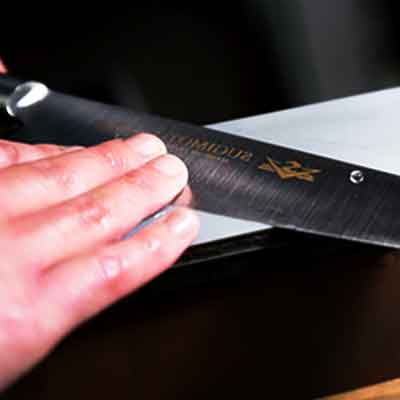
Once you are done removing all the chips and thinning the knife, the last part will be to sharpen the edge of your Japanese knife.
Here is how to go about it.
Step 1:
- Get a 1000-grit stone and set the angle for your knife to 15 degrees which are recommended.
- However, you can still set the knife to 20-degrees if you would like to end up with a much stronger blade.
Step 2:
- Next, move the knife back and forth in slow motion from the tip to the heel on the sharpening stone.
- Once you have done a few passes on one side, you should repeat the same with the other side until you raise a good size burr and then deburr.
Step 3:
- For the best results, you will need to sharpen the knife again using a 4000-grit stone at a 20-degrees angle.
- Then, use a leather strap to remove any remaining burrs and test if the edges are as smooth as you would like them to be. And that’s it! You finally fixed your chipped Japanese knife.
Some Tips On Avoiding Chip On Japanese Knife
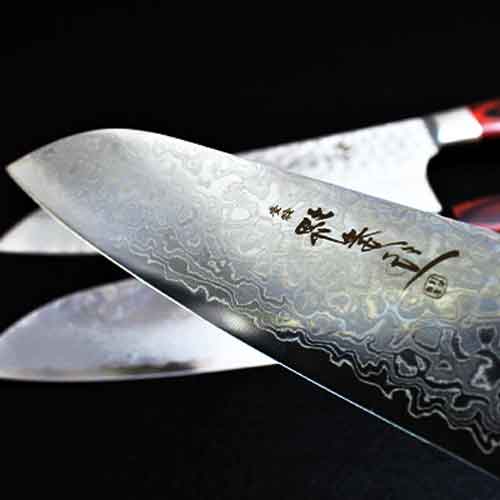
Sure, it is possible to fix your chipped knife, which is a good thing. But what if there was a way to actually protect your blade from chipping in the first place?
Your knife would probably last forever, thereby saving you money that you could have spent on buying another one.
In this section, we’re going to discuss some of the tips that could help you avoid chips on your Japanese knife. Check them out.
Tip#1:
- You should not use your knife to debone chickens because the blade of a Japanese knife is too thin and, hence, could easily chip if you apply too much pressure on it.
- So, when your knife does not want to go any further as you cut your chicken, just let it be.
Tip#2:
- Never use your knife on frozen or half-frozen ingredients because cold temperatures only make your knife’s blade more brittle.
- However, you can use it to cut foods at room or fridge temperatures.
Tip#3:
- If cutting cheese, don’t even think of using your knife because the blade will not go through.
- And if you try to force its way through the cheese, it will chip your knife’s blade.
Tip#4:
- You should never use your knife to cut ingredients on ceramic, granite, marble, glass, or metal chopping boards.
- These boards are quite hard and could potentially cause your blade to chip.
- Instead, you should use plastic or soft wooden boards.
Tip#5:
- Always handwash your knife.
- Washing it in the dishwasher can lead to chipping because of the high heat and so much banging against other cutleries, plus the metal shelves of the dishwasher.
Tip#6:
- Increase the edge angle if you notice that your knife is developing small chips at the edge.
- For instance, if your knife’s angle is 12-degrees on both sides, you could increase it to 15-degrees and observe if it helps minimize the chipping.
Tip#7:
- Use the right technique while cutting with your Japanese knife.
- For example, you should avoid twisting the knife through the cuts because it could cause chipping.
- Also, be sure to avoid cutting into the chopping board.
Tip#8:
- Always wash and dry your knife immediately after every use to keep those pesky knife chips at bay.
- This is because when the cutting edge has moisture on it or any kind of wetness, it may weaken your knife’s blade, thereby promoting chipping.
Tip#9:
- Be careful when handling your knife to ensure you don’t drop it on a hard surface like a granite countertop, concrete floor, or a tiled floor, as this could chip the edge.
Tip#10:
- Never push your ingredients across the chopping board using your Japanese knife after the cut.
- Scrapping the sharp edge of your knife against the board can result in the blade becoming chipped.
Final Thoughts
Once you have had your Japanese knife for quite a long time, it may get brittle with regular use and eventually become prone to chipping.
Luckily, with proper care and usage, you can minimize the occurrence of these chips on your knife.
But if your knife still chips accidentally, you don’t have to worry much because there are effective methods on how to fix chipped Japanese knife. This way, you won’t end up throwing it away and having to buy another one.


